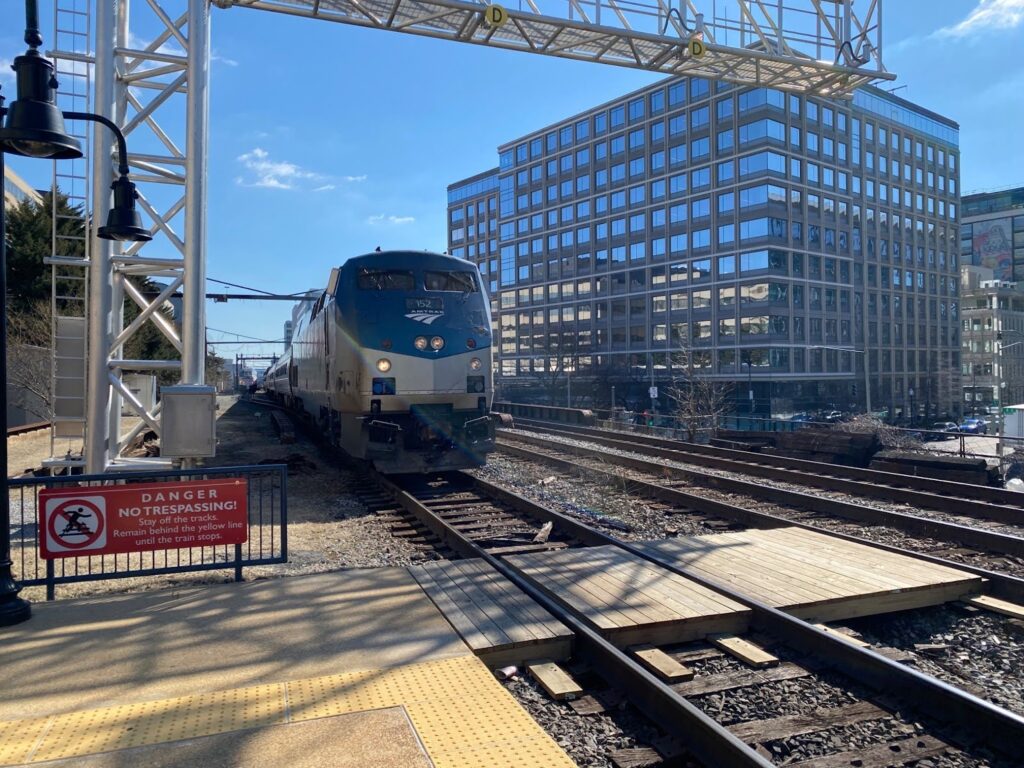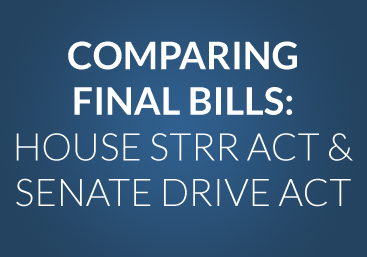
With conference underway, how do the House and Senate bills stack up?

While the multi-year transportation bills passed by the House last week and the Senate back in July are fairly similar, there are still some notable differences between the two. With the conference committee getting underway to reconcile the bills, it’s worth looking at the similarities and differences.
While we believe both of these bills largely represent three (or possibly six) more years of the status quo for the most part, there are still some provisions within each bill worth fighting for in conference. Unfortunately, however, for some of our most significant priorities, that ship may have sailed. It’s unlikely that anyone will be successful in getting provisions inserted during conference which aren’t currently found in either bill. So if something isn’t already included in the House or Senate bill, it’s almost certainly not going to be included during conference (e.g. the Davis-Titus/Wicker-Booker local control amendment).
We’ll be keeping a close watch on the conference committee over the next week, so stay tuned. The staff of the conferees is meeting this week while Congress is on recess, and the members will meet next week for the first time. They’ll have to produce a deal and pass it through both chambers again before next Friday (November 20th) in order to avoid having to pass another short-term extension of MAP-21.
We produced a much more detailed summary for our members that also includes all named and likely conferees and how the bills stack up to T4America’s platform, available below.
[member_content]Members, we produced a much more detailed memo for you, which provides a detailed chart comparing each bill to one another as well as a comparison to the seven goals contained in our policy platform. You can access that detailed summary here.[/member_content]
The two bills are similar in their overall approach to funding. The overall levels are slightly better in one bill or the other for several key programs, and neither bill made any progress toward providing new sustainable revenues for our nation’s transportation trust fund.
This searchable table below covers 11 key provisions or big-picture goals and how the Senate and House bills stack up on each point.
| Item | Senate DRIVE Act | House STRR Act |
|---|---|---|
| Does the bill stabilize the trust fund with new sustainable revenue sources? | No. It does not raise or index transportation user fees. The bill uses $45 billion in largely non-transportation funding sources to fill the gap between gas tax revenues and spending in the bill. Unlike the House bill, it only partially funds the bill for 3 out of 6 years. | No. It does not raise or index transportation user fees. The bill adopted most of the Senate's funding sources and added the option of using an infusion from the Federal Reserve surplus account to fund the last 2-3 years of the bill. (Where did that extra funding come from? Read this post.) |
| Funding levels | The Senate bill provides about $350 billion over six years. | The House provides about $325 billion over six years. |
| Complete Streets Join with the National Complete Streets Coalition in sending a message to the conferees urging them to adopt the Senate language. | The Senate bill requires states and MPOs to incorporate Complete Streets standards. It allows NACTO’s Urban Design Guide as a required design manual to be used by USDOT when developing the nation’s design standards, and will permit a local government to use its adopted design guide, even if it differs from the state’s. | The House bill only "encourages" states and MPOs to incorporate Complete Streets standards. The House bill does also include NACTO's design guide and allows local governments to use their preferred guide even if it conflicts with the state's |
| Local control & funding | The Wicker-Booker amendment to increase local funding and control was not included. The Senate bill provides less money for local communities than the House bill. • It suballocates 55% of the Surface Transportation Program to locals instead of 50%. • A smaller pot of STP funds overall = fewer total dollars going to local communities. | The Davis-Titus amendment to increase local funding and control was not included. House bill does provide slightly greater funding for local communities. The Surface Transportation Program increases with inflation, and the amount suballocated to local governments increases by 1% per year until it reaches 55%. |
| TIGER grants | Does not authorize TIGER or any other multimodal discretionary grant program. | Does not authorize TIGER or any other multimodal discretionary grant program. |
| TIFIA loans for TOD projects | Yes. The Senate bill lowers the cost threshold for local, TOD and ITS projects to apply for TIFIA loans from $50 million to $10 million, and makes transit-oriented development projects eligible. | No. The House lowers the cost threshold for projects to apply for TIFIA loans from $50 million to $10 million. It does NOT make transit-oriented development projects eligible. |
| Rail improvement grants for TOD projects | No. Transit-oriented development projects are not eligible to apply for loans from this financing program that provides low interest federal loans to public and private entities to improve rail infrastructure and assets. | No. Transit-oriented development projects are not eligible to apply for loans from this financing program that provides low interest federal loans to public and private entities to improve rail infrastructure and assets. |
| More performance measures? | No significant progress. MAP-21 took the first step in a transition to a performance-based system of investing dollars based on measurable outcomes and return on our investments. Neither bill takes the next logical, significant step forward in this regard. | No significant progress. MAP-21 took the first step in a transition to a performance-based system of investing dollars based on measurable outcomes and return on our investments. Neither bill takes the next logical, significant step forward in this regard. The House bill does include a new performance measure intended to “assess the conditions, accessibility, and reliability of roads in economically distressed urban communities.” |
| Transportation Alternatives Program | Senate caps the TAP program at $850 million per year (higher than the House), and suballocates 100% of it to metro areas. | House caps the TAP program at $819 million per year (less than Senate) and moves it within the STP program. It maintains status quo of sending 50% of the program to states and 50% to metro areas. |
| Passenger rail | Both House and Senate will likely include a passenger rail title in the final bill. The Senate incorporated theirs into the DRIVE Act while the House passed theirs separately. | Both the House and Senate will likely include a passenger rail title in the final bill. The House rail proposal will effectively separate the Northeast Corridor from the rest of the national system and prioritize funding for this segment at the expense of planned rail development throughout the rest of the country. |
| Transit & transit funding | The Senate bill marginally increases funding for transit. Other policy changes are relatively minor. | The House decreased the allowed federal match in New Starts capital transit grants from 80 to 50 percent and restricting locally-controlled STP funds for counting as local match dollars. |



